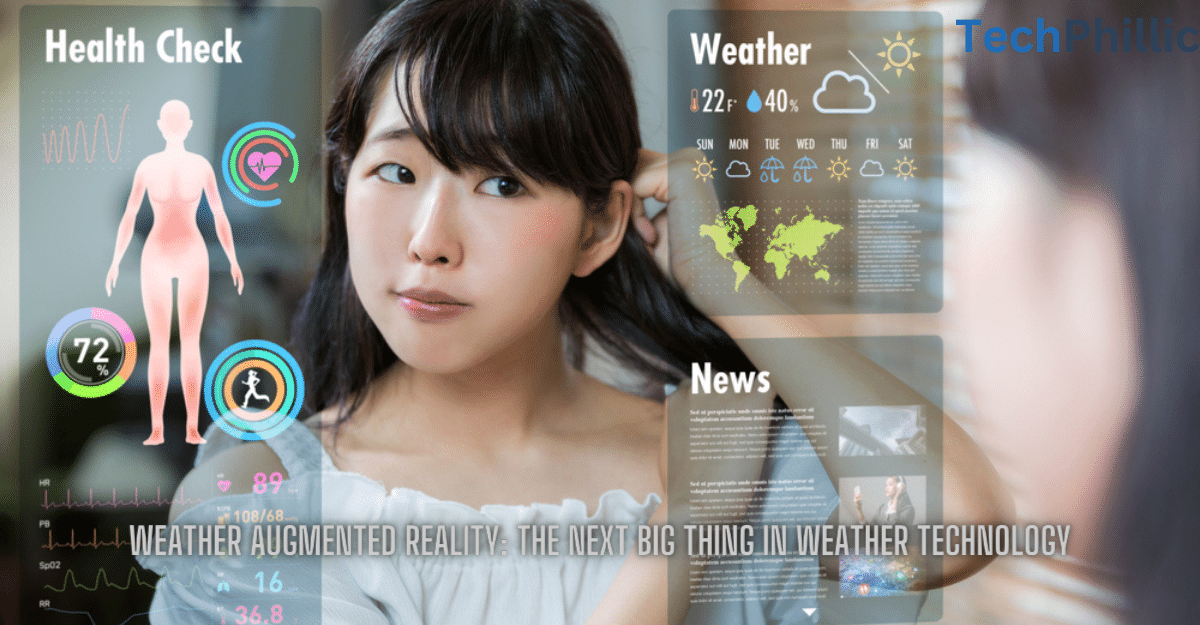Weather augmented reality (AR) is a technology that overlays weather information onto the real world, in real-time. This can be done using a smartphone, tablet, or other AR-enabled device. Weather AR has the potential to revolutionize the way we interact with weather information, making it more accurate, informative, and engaging.
History of Weather AR
The concept of weather augmented reality has been around for several years, but it has only recently become a reality thanks to the development of new AR technologies. In 2015, the company AccuWeather released the first weather AR app for smartphones. This app allowed users to see the current weather conditions and forecast for their location overlaid in the real world. Since then, several other weather AR apps have been released, and the technology is continuing to evolve.
Benefits of Weather AR
There are many benefits to using weather AR. Here are just a few:
- Improved accuracy: Weather augmented reality can provide more accurate weather information than traditional weather forecasting methods. This is because weather AR can use real-time data from sensors and satellites to create a more accurate representation of the current weather conditions.
- Increased situational awareness: Weather augmented reality can help users to better understand their surroundings and to make more informed decisions about their activities. For example, weather AR can be used to see the current wind speed and direction, so that users can avoid being blown off course while hiking.
- Enhanced safety: Weather augmented reality can help users to stay safe in extreme weather conditions. For example, weather AR can be used to see the location of upcoming storms, so that users can take shelter before it is too late.
- Increased convenience: Weather augmented reality can make it easier for users to get the weather information they need. For example, AR can be used to see the weather forecast for your current location without having to open a weather app.
- Engaging and educational: Weather AR can be a fun and engaging way to learn about weather. For example, weather AR apps can be used to create interactive games and simulations that teach users about different weather phenomena.
Applications of Weather AR
Weather AR can be used in a variety of applications, including:
- Planning outdoor activities: Weather augmented reality can be used to plan outdoor activities such as hiking, camping, and fishing. Weather AR can help users to see the current weather conditions and to forecast the weather for the next few days. This information can be used to make sure that outdoor activities are safe and enjoyable.
- Staying safe in extreme weather: Weather augmented reality can be used to stay safe in extreme weather conditions such as thunderstorms, hurricanes, and blizzards. Weather AR can help users to see the location of upcoming storms and to forecast the severity of the weather. This information can be used to take shelter and avoid dangerous situations.
- Making better travel decisions: Weather augmented reality can be used to make better travel decisions. Weather AR can be used to see the current weather conditions at your destination and to forecast the weather for the next few days. This information can be used to decide whether or not to travel and to plan your trip accordingly.
- Everyday use: Weather augmented reality can be used for everyday tasks such as checking the weather before you leave the house, finding out if it is going to rain before you go for a walk, or seeing if there is a storm coming.
- Education: Weather augmented reality can be used to educate students about weather. Weather augmented reality apps can be used to create interactive games and simulations that teach students about different weather phenomena.
- Entertainment: Weather augmented reality can be used to create entertainment experiences. For example, AR apps can be used to create interactive weather shows or to add weather effects to movies and games.

Current Limitations of Weather AR
While weather AR has many potential benefits, there are also some limitations to the technology. Here are a few of the limitations of weather AR:
- The need for accurate data: Weather AR requires accurate data to be effective. This data can be difficult to obtain in some areas, especially in remote areas.
- The limited availability of weather AR apps: There are a limited number of weather AR apps available on the market. This is because weather AR is a relatively new technology.
- The high cost of weather AR hardware: The hardware required to use weather AR can be expensive. This is a barrier to entry for many users.
Also Read: Cryonics: Bridging Science Fiction with Medical Dreams
Future of Weather AR
Weather AR is still a relatively new technology, but it has the potential to revolutionize the way we interact with weather information. As technology continues to evolve, we can expect to see more accurate, affordable, and accessible eather augmented reality apps.
We can also expect to see whether AR is being used in a wide variety of new and innovative ways. For example, weather AR could be used to help farmers monitor their crops, help firefighters fight wildfires, and to help emergency responders manage disasters.
Ultimately, the future of weather AR is very bright. Technology has the potential to revolutionize the way we interact with weather information, and we can expect to see it being used in many new and innovative ways in the years to come.
Here are some additional thoughts on the future of weather AR:
- As weather AR technology continues to improve, we can expect to see it being used in more and more applications. For example, weather AR could be used to help people plan their travel, stay safe in extreme weather conditions, or learn more about the weather.
- Weather AR could also be used to create new and engaging ways to experience the weather. For example, weather AR could be used to create virtual weather parks where people can explore different weather phenomena in a safe and controlled environment.
- The development of weather AR has the potential to make weather information more accessible and understandable to everyone. This could help people to make better decisions about their lives and to be more prepared for extreme weather events.
Conclusion
Weather augmented reality (AR) is a powerful technology that has the potential to revolutionize the way we interact with weather information. It is already being used in a variety of applications, and its use is only going to grow in the future. If you are interested in the future of weather technology, then you should keep an eye on weather AR.
Here are some of the reasons why weather AR is so promising:
- It can provide more accurate weather information than traditional methods.
- It can be more informative, by overlaying additional information on the real world, such as the temperature, wind speed, and precipitation.
- It can be more engaging, by creating a more immersive experience for users.
- It can be used in a variety of applications, such as helping people plan outdoor activities, staying safe in extreme weather conditions, and making better travel decisions.
As the technology continues to develop, we can expect to see whether AR is being used in even more applications. It has the potential to become a part of our everyday lives, helping us to make better decisions about our activities and to stay safe in extreme weather conditions.
If you are interested in learning more about weather AR, there are several resources available online. You can also download weather AR apps to your smartphone or tablet to try it out for yourself.
Weather augmented reality app
- AccuWeather AR: AccuWeather AR is one of the most popular weather AR apps available. It provides accurate weather information, including temperature, wind speed, precipitation, and UV index. It also overlays this information onto the real world, so you can see it in your surroundings.
- WeatherAR: WeatherAR is another popular weather AR app. It provides similar information to AccuWeather AR, but it also includes several additional features, such as the ability to see the forecast for different locations, and the ability to create custom weather alerts.
- SkyView® Lite: SkyView® Lite is a weather AR app that focuses on astronomy. It allows you to see the stars, planets, and constellations in the sky above you. It also provides information about the weather, such as the temperature, wind speed, and precipitation.
- StormRadar: StormRadar is a weather AR app that focuses on severe weather. It allows you to see live radar imagery of storms, and it also provides information about the location and severity of storms.
- Weather Live: Weather Live is a weather AR app that provides a variety of weather information, including temperature, wind speed, precipitation, and UV index. It also overlays this information onto the real world, and it allows you to create custom weather alerts.







